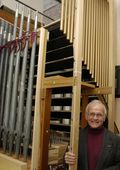 Steve Maurer is a diverse professional. Jobs on his resume range from a high school German teacher to mayor of Botkins, Ohio. He also served as director of the Ohio Department of Agriculture and is currently the state executive director for the Ohio Farm Service Agency — a position he previously held from 1993-2001.
Steve Maurer is a diverse professional. Jobs on his resume range from a high school German teacher to mayor of Botkins, Ohio. He also served as director of the Ohio Department of Agriculture and is currently the state executive director for the Ohio Farm Service Agency — a position he previously held from 1993-2001.
Yet with such prestigious positions, it’s hard to imagine that the former chief of the Division of Natural Areas and Preserves for the Ohio Department of Natural Resources, has rare woodworking skills that allowed him to take a break from the business world and spend time rebuilding pipe organs at a Columbus, Ohio company.
While rehearsing with the Columbus Maennerchor — a German-American choral group — Maurer found himself in a pipe organ discussion with the owners Bunn-Minnick Pipe Organ Company. “The discussion ended with me asking whether they had anything for an underemployed Democrat,” said Maurer. “I started work the following week.”
The Bunn Minnick Company has been crafting, restoring and adding-on to virtually every make of domestic pipe organs since the late 1700’s. The company believes that much of the past is worth preserving and blending with the present to provide continuity.
“There are various skills and skill levels required in organ building,” said Maurer. “Most of my work was in basic wood working, though at some point everyone has a hand in most everything.
By everything, Maurer refers to the engineering acoustical engineering, carpentry, cabinetry, electronics, pipe building, voicing and tuning needed to build an organ.
An organ chest is the wooden base that forms the foundation where the pipes are mounted. Each pipe, which ranges in size from a pencil to an average person, receives air through a specific hole in the wood chest. Using Ohio’s native tulip poplar tree is ideal for organ chest construction because it is easy to work with.
Each airway leading to a pipe must be meticulously bored and sealed with polyurethane to stop the air from traveling to the wrong pipe, and each pipe’s fit to the chest must be precisely drilled to insure an air tight fit.
Electromagnetic valves control the air flow to each pipe as directed by the organist through keys, pedals and stops. The result is a rich chorus of pipe harmonics that owes part of its tone to the deciduous tulip poplar trees.
“Working in this centuries-old craft is both fascinating and rewarding,” said Maurer, who worked four years at the Bunn Minnick Pipe Organ company prior to accepting the SED position last year. “Crafting Ohio’s natural hard wood into a complex musical instrument that lifts the spirit and revitalizes the soul, nears the sublime.”
—by Michael Kaufman, regional public affairs specialist





